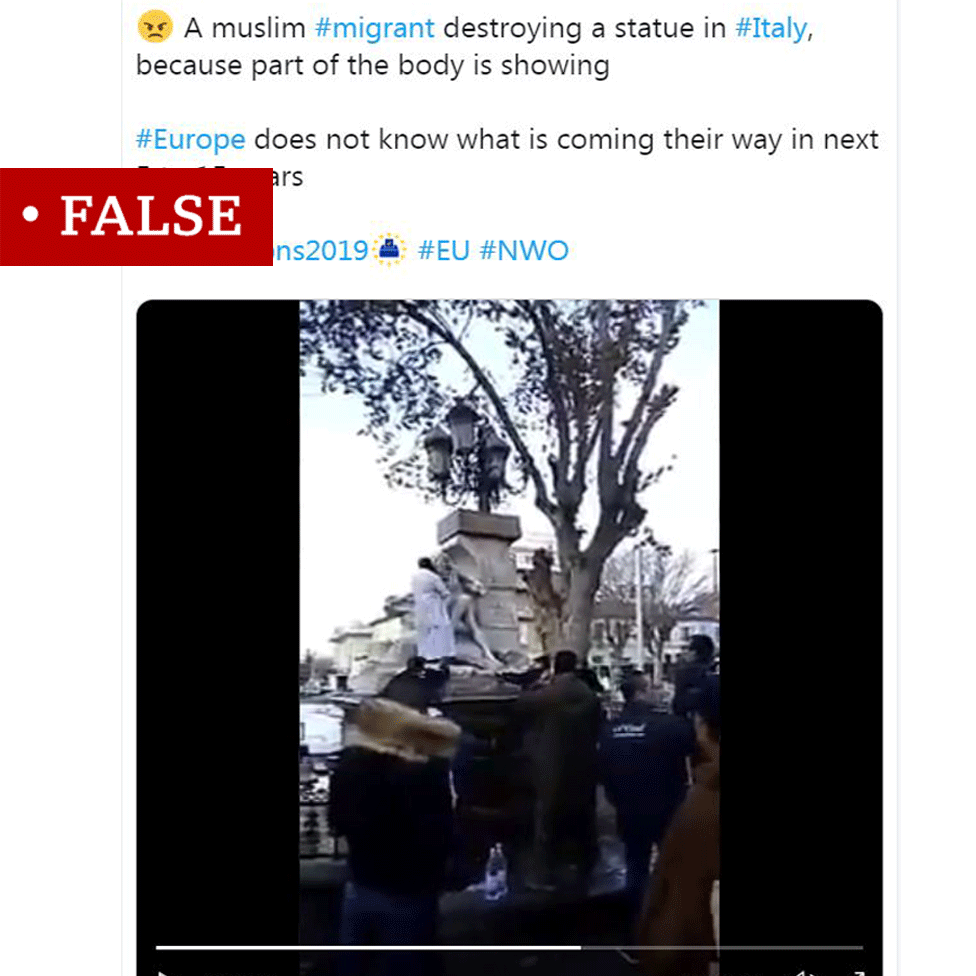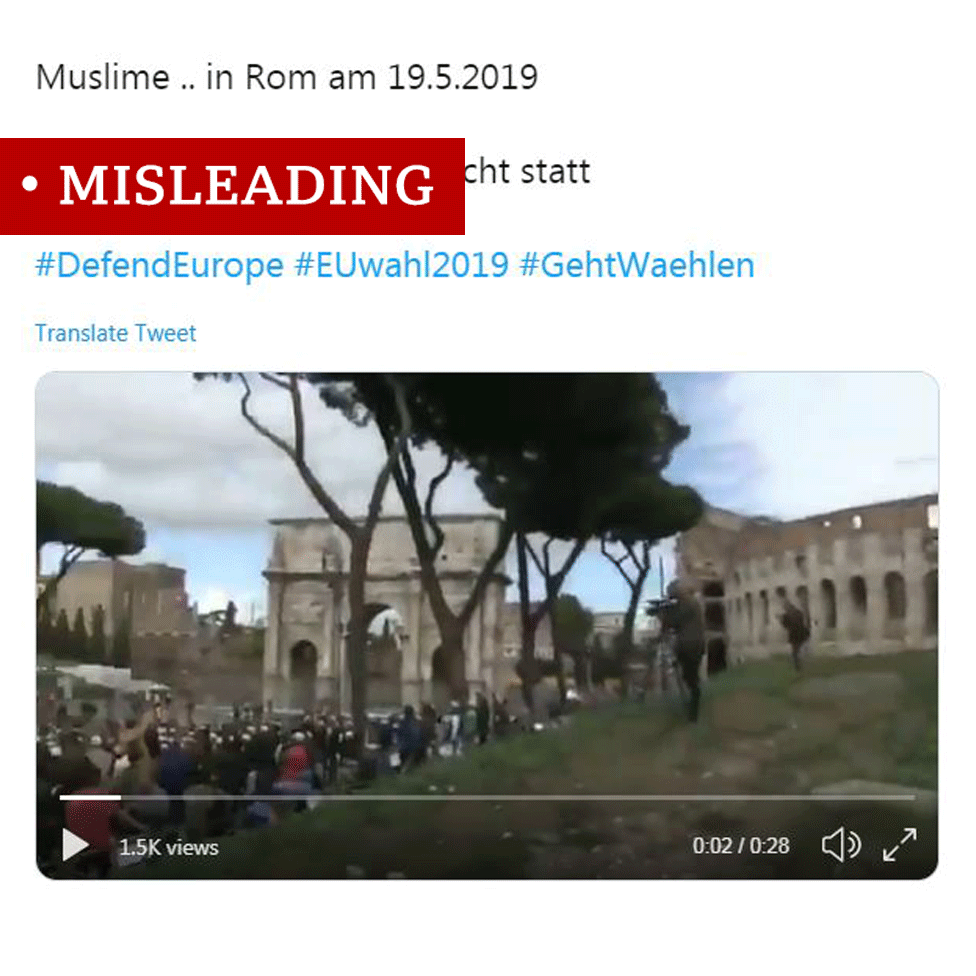European elections 2019: Investigating false and misleading video
- Published

In a heated European election campaign, parties and their supporters used social media to debate some of the biggest issues affecting Europe today.
However, as many feared, there were cases of misleading information being widely shared online.
It came from a range of sources, including groups criticising political rivals, or accounts publishing large volumes of content on specific subjects such as migration.
BBC Reality Check and BBC Monitoring have examined some examples and attached labels where they've been found to be "false" or "misleading".



One of the most widely-shared posts on Twitter under the hashtag #euelections2019 was a video of a man attacking a statue of a woman, which was falsely described as taking place in Italy.
In the recording, a crowd has gathered around the statue as the man uses a hammer and chisel to deface the female figure. Onlookers throw things to try to stop him before the police arrive and drag down the man.
The caption of the video posted by one Twitter account, which received thousands of views and shares, reads: "A muslim #migrant destroying a statue in #Italy, because part of the body is showing. #Europe does not know what is coming their way in next 5 to 15 years."
However, the incident did not take place in Italy - the statue in the video was part of the Ain El Fouara fountain in Setif, Algeria.
Various media outlets, including an Egyptian television station, news agency Agence France Presse (AFP) and TV network France24, reported on the incident in Algeria at the time, which took place in December 2017. Reports at that time contained footage resembling the video posted recently.
For further confirmation of the location, details from the video match photos of the monument in Setif.
There is the statue itself and the distinctive street lamps above it. A street view shows the same buildings surrounding the square in Setif that appear in the video.
Some posts claimed that the statue is of the Virgin Mary. But in fact it is of a mythological creature called a Naiad, reported AFP., external
Multiple versions of the video posted in different languages appeared on social media and, despite it being debunked by fact-checking organisations, it generated tens of thousands of shares and referrals in recent weeks. A version of the video uploaded last year has reached 2.7 million total views on Facebook.

The role of negative memes
Countless election memes and unofficial pledge cards were created to mock and, in some cases, misrepresent politicians.
A mocked up election pledge card bearing the centre-left Italian Democratic Party (PD) logo wrongly linked a quote about Libyan refugees to the party leader Nicola Zingaretti.
It said that after the party won the European elections, it would ask Europe to pass a "directive to open all Italian ports to immediately receive 800,000 Libyan refugees".
The PD confirmed to the BBC that Mr Zingaretti never made this statement and that those responsible for the claim have been reported to the police.
The memes were shared by groups supporting right-wing policies.
The United Nations-backed prime minister of Libya mentioned the 800,000 figure in a recent interview with an Italian newspaper.
But the figure he referred to appeared to be a rough estimate of the overall number of people who "could try to reach Italian ports" if the situation in Libya continues to worsen.
The Italian foreign minister responded by saying there was no evidence for this high number.
Just over 1,000 migrants have entered Italy across the Mediterranean sea this year, according to the UN., external
Last year there were 23,370 arrivals, significantly fewer then the previous years when more than 100,000 migrants entered the country annually.

French president egged
Footage of Emmanuel Macron being heckled and having an egg thrown at him as he entered a building was shared on Facebook, Twitter and Reddit.
A UK-based Facebook page published a version of the video on 5 May under the caption: "Footage has emerged this week of President Macron being egged and receiving an extremely hostile welcome and it almost spirals out of control. Imagine this had happened to President Putin? It would be all over the BBC and MSM!"
In April, a German Facebook account posted the same video, which has been shared more than 4,000 times and viewed nearly 200,000 times.
An article on a Dutch website suggested the media refused to publish the video.
However, the recording was from 2016 when Mr Macron was economy minister and a crowd of protesters in Paris confronted him about labour reforms.
Lots of outlets reported on the incident at the time including the Daily Telegraph and Euronews.

Old protests at Rome's Colosseum
There have been plenty of examples of old videos being recycled, making it unclear when the footage was first taken. For example, a recording from 2016 that emerged recently of Muslim worshippers outside the Colosseum in Rome.
Two Twitter accounts claimed (though their tweets were not widely shared) that Muslims had gathered there on 19 May 2019.
The same video was posted by anti-Islam Dutch politician Geert Wilders.
Another account suggested Muslims were protesting against current Italian interior minister Matteo Salvini for closing down mosques.
Using an online video verification tool and a Google reverse image search of a thumbnail from the video, it can be traced back to a piece on an Italian website in October 2016, which was filmed during a protest by hundreds of Muslims against the closure of makeshift mosques in Italy.
The 2016 video has the same audio and sequence of shots - the camera pans to the crowd gathered to the left of the Colosseum and shows people arriving.



- Published20 May 2019
